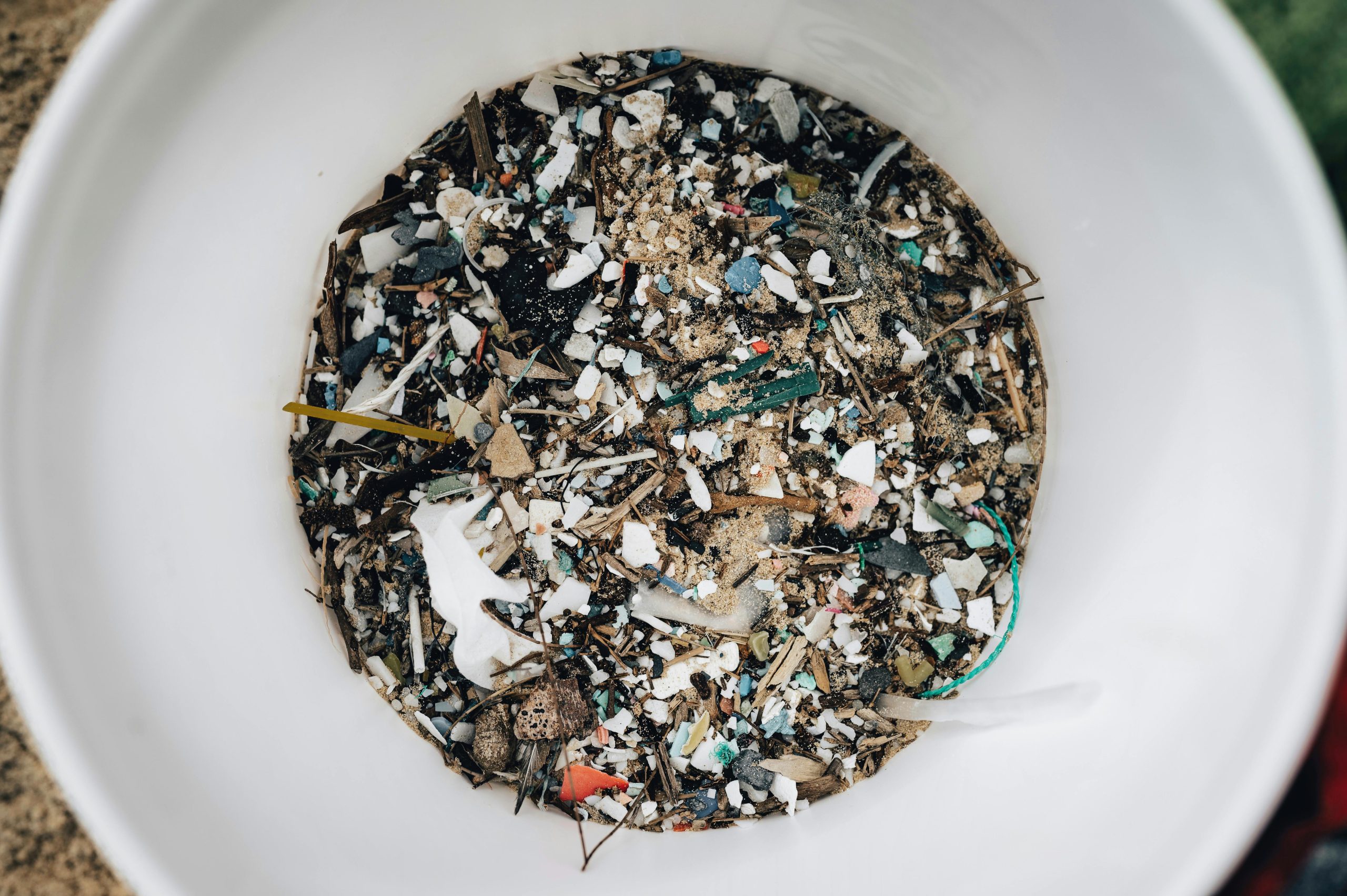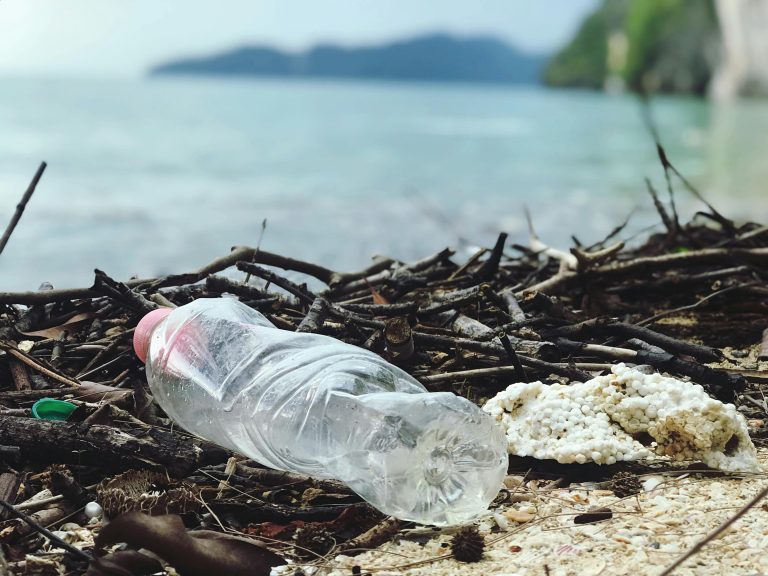What Microplastics Are Doing to the Brain, Body, and Reproductive Systems
Article Key Takeaways
Article Outline
- Introduction: The Ubiquity of Plastic in Daily Life
- How Microplastics Get into Our Bodies
- Chemical Companions: BPA, BPS, Phthalates
- Where Microplastics Accumulate
- Microplastics and Hormones
- Potential Cancer Links
- What You Can Do: Reducing Microplastic Exposure
The Hidden Threat: Microplastics Everywhere
Plastics are all around us.
It seems like every product that humanity consumes is either made of or packaged in plastic. From the obvious ones you’d expect like single use plastics (water bottles, food packaging) to the less well known ones like the plastic that’s in a lot of your clothing, it’s an exponentially growing component of what we consume as well as an ever growing risk to human health.
You are likely taking in tens of thousands to potentially millions of tiny plastic particles every year without even knowing it (Springer Nature).
These tiny bits of plastic don’t just pass through your body either; they build up in your organs and tissues. Early in 2024, studies found that human brain samples had about 0.5% plastic by weight. In brains of people with dementia, plastic levels were found to be up to 10× higher than in those without dementia (The Guardian).
In the reproductive system, higher levels of plastics like PVC have been linked to lower sperm counts. It doesn’t stop there. Plastics often contain harmful chemicals like BPA, BPS, and phthalates. These chemicals are used to make plastics harder and more lasting, but are known to mess with hormone levels, change how our bodies work, and have been linked to many health problems, from issues with reproduction to brain development.
Possible worst of all, all of these plastic materials are leaching microplastics.
Microplastics are tiny, ranging from the size of a grain of rice down to a thousand times smaller than a grain of sand, called nanoplastics. These particles come from two primary sources.
First is bigger plastic items breaking down over time, over and over and over again, leading to smaller and smaller plastic particles. The second are tiny plastics that are put into everyday items on purpose, like microbeads in makeup and fibers in our clothing.
So, how do these microplastics get into our bodies, and why are they so common? By eating and breathing them in.
We take them in through bottled water, tap water, packaged foods, and even fresh produce that’s been touched by dirty soil and water. We breathe in these microplastic particles floating in the air, especially in cities, where tiny fibers from clothes and broken-down plastic waste get into the air. They don’t just pass through us; they build up. They’ve been found in the lungs (The Guardian), liver, heart, brain, reproductive organs, and even in the placenta.
Tap water alone can lead to taking in anywhere from 220,000 to 1.2 million microplastic particles per year, depending on where it comes from (Dr Rhonda Patrick). Studies show that people who only drink bottled water might take in up to 90,000 more plastic particles each year compared to those who only drink tap water (CBS News).
A 2022 study found that microwaving food in plastic containers can release over 4 million microplastic particles into a meal in just 3 minutes, along with 2 billion nanoplastics (PubMed).
Given the vast quantity of data that’s emerging that highlights the alarming amount of plastic that humans consume, it’s clear that each person needs to take action to reduce their exposure to microplastics.
Plastic Chemicals Harm Your Health: BPA, BPS and Phthalates
Plastics often have chemicals added to them, like BPA, BPS, phthalates, and PFAS (often called “forever chemicals”) for many different applications. These chemicals come with big health risks.
BPA and BPS
BPA and BPS, for example, can act like estrogen in the body, leading to hormone problems that affect everything from reproductive health to brain function. A study found that drinking from aluminum cans lined with BPA can raise blood pressure in just a few hours (NIH), showing how quickly these chemicals can affect our cardiovascular system.
What’s even more concerning is how easily these chemicals can leak out of plastics, especially when heated or when they touch acidic or fatty foods. Heating polycarbonate bottles to just 100°C can increase the release of BPA by up to 55 times (Environmental Health Perspectives).
There’s a possible link between BPA and autism spectrum disorder. Many human studies suggest a connection between a mother’s BPA levels and a higher chance of brain development problems, including autism. (The Treetop)
For example, a study found that higher BPA levels in pregnant women were linked to behavior problems in their children, especially boys, including anxiety, aggression, and social problems, which are similar to autism symptoms. Another study found that higher BPA exposure during pregnancy was linked to poor brain development in children, including behavior problems, again more so in boys. A review of studies on maternal BPA exposure and brain development, while not proving a direct link to autism, found consistent evidence that BPA exposure before birth increased the risk of behavior issues like hyperactivity and inattention, common in children with autism.
Phthalates
Phthalates are another group of chemicals used to make plastics more flexible. You can find Phthalates commonly in PVC products (think flooring, shower curtains, and some food packaging), cosmetics (nail polish, hair spray) and many beauty products.
They’ve been linked to hormone problems where they disrupt the endocrine system in your body (NIH), reproductive issues, and development problems in children. Research has shown that higher levels of phthalates are connected to lower testosterone levels in men, affecting muscle, mood, and more. (HealthDay).
Microplastics in Our Bodies: They are Accumulating in your Lungs, Brain and Blood.
Microplastics in Your Blood
Microplastics don’t just pass through our bodies; they build up. Every breath, every bite, every sip brings these tiny plastic particles into our system. One of the most effective ways microplastics reach our organs is through our bloodstream. A 2022 study found microplastics in the blood of 80% of participants when looking at the limits of quantification, confirming that once microplastics enter our bodies, they can travel in our blood and settle in different tissues and organs (Environment International).
The other 20% of participates in this study still likely had traces of plastics in their body, just not enough to qualify them for the level that this particular study wanted to measure.
Microplastics in your Brain
What’s most concerning is the brain. Early in 2024, studies found that human brain samples had about 0.5% plastic by weight. In both animal and early human studies, microplastics have been found to cross the blood-brain barrier, a protective layer for the brain. Once inside, they can activate brain immune cells, which can cause swelling in the brain. Over time, this might lead to brain diseases like Alzheimer’s and Parkinson’s. A study with mice exposed to microplastics found higher levels of swelling chemicals in the brain and changes in behavior, suggesting brain damage.
Brain tissue from people who had been diagnosed with dementia had up to 10 times as much plastic in their brains as those who were not diagnosed with dementia. (University of New Mexico). While this isn’t a direct cause and effect relationship, it’s an alarming statistic that greatly warrants further investigation into debilitating conditions like dementia and the role that everyday plastic products play.
What’s also striking is the increase in microplastic levels over time. Human brain samples from 2024 had about 50% more plastic than similar samples from 2016 (Nature). This trend matches the rising levels of microplastics in the environment, suggesting that as plastic pollution goes up, so does plastic buildup in human tissues like the brain.
The question is, what does long-term, low-level exposure look like for humans, especially in cities where microplastic air pollution is high? And what about kids? During early development, the blood-brain barrier is even more open, meaning pregnant women and young children could be at a greater risk for brain development problems like autism or ADHD if exposed to microplastics. The early signs are not good.
Microplastics in your Lungs
In 2022, a study found microplastics in every lung sample from surgical patients, even those with no special environmental exposures beyond daily life (NPR). In the lungs, microplastics can cause swelling and stress, leading to breathing problems like asthma.
A study on lung cancer patients found microplastic particles in tumor tissue, suggesting these foreign particles might play a role in cancer development or progression (Springer). The presence of microplastics in tumor tissue is alarming because they can cause chronic swelling and possibly carry harmful chemicals directly into the tumor area. While it’s not yet clear if these particles directly cause cancer, the fact that they can get into tumor tissue highlights their potential to affect tumor biology, possibly by making swelling worse or interfering with immune responses. More research is needed, but the early data is concerning.
Microplastics and your Heart Health
A study found that patients with carotid artery plaque in which MNPs (Microplastics and Nanoplastics) were detected had a higher risk of a composite of myocardial infarction, stroke, or death from any cause like a heart attack or stroke (NIH).
Hormonal Havoc: Endocrine and Reproductive Effects
BPA and phthalates are well-documented hormone disruptors. Human studies have shown that higher levels of BPA are linked to problems with sex hormone levels and thyroid function (European Environment Agency). Animal studies have shown that long-term exposure to BPA and phthalates not only messes with hormones but also causes physical changes. Male animals exposed to BPA had fewer sperm, less active sperm, and changes in testosterone. Female animals showed problems with ovaries, earlier puberty, and irregular cycles (Nature)
In men, research shows that higher phthalate levels are linked to lower sperm quality and reduced testosterone, directly affecting fertility and hormone balance. (NIH)
In women, higher phthalate levels are linked to irregular periods and a higher chance of endometriosis, a painful condition that can lead to fertility problems. (NIH)
Phthalates mess with estrogen paths, which are important for regulating the menstrual cycle and reproductive health. These chemicals get into our bodies through everyday products, water, and air. Phthalates don’t need to be at high levels to cause problems; they quietly cause damage to our hormone systems that builds up over time, affecting development, including brain development.
Do Microplastics Cause Cancer?
While it’s not definitively proven that microplastics cause cancer in humans, research suggests a potential link and raises concerns.
According to Hartford Healthcare, there are a many possible compounding factors that could play into plastics their potential role in causing cancer.
Early research suggests microplastics may also trigger inflammation, oxidative stress and DNA damage — factors that can contribute to cancer.
“But so far, no human studies have directly linked microplastics to cancer,” says Dr. Salner. “Researchers are still working to understand their potential role. Some researchers speculate that microplastics may magnify the role of other toxins.”
Also, Molecular Cancer shares that there are studies that find associations between microplastics and many forms of cancer, like lung, liver and breast cancer, but also acknowledges that there is a lot more investigation that needs to be conducted to better understand the relationship between plastics and cancer.
Reducing Your Exposure to Microplastics: Practical Steps
You can’t completely eliminate microplastics from your life—but you can reduce your exposure to them and their chemical bi-products.
- Avoid heating food in plastic and cooking with plastic utensils. Even “microwave-safe” plastic can leach chemicals.
- Use glass, ceramic, or stainless steel containers instead of plastic.
- Look for beauty and cosmetic products that don’t contain plastics of phthalates.
- Install a reverse osmosis filter at home to remove up to 99% of microplastics and contaminants.
- Don’t drink beverages from plastic bottles. Opt for glass or aluminum and use re-usable water bottles.
- Eat fresh food instead of packaged. Avoid cans and plastic-wrapped items. Try to avoid using the plastic product bags and grocery stores and bring your own reusable ones.
- Choose clothing made from natural fibers like cotton, wool, or hemp.
- Use a HEPA air filter and vacuum with a HEPA-equipped cleaner to reduce airborne microplastics.
- Avoid thermal receipts (which contain BPA) and opt for digital receipts when possible.



